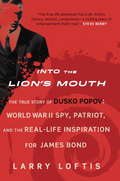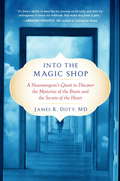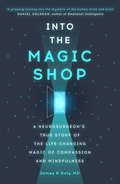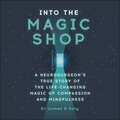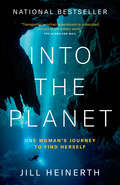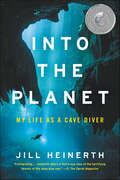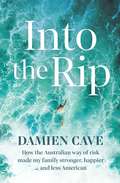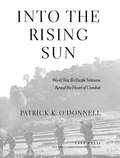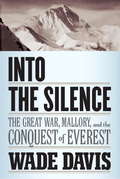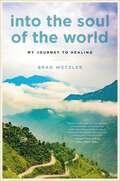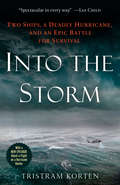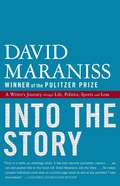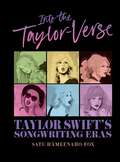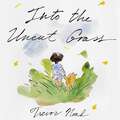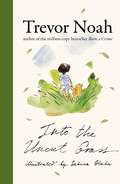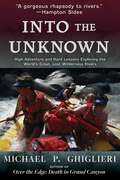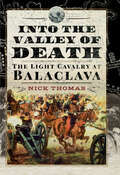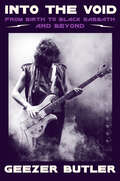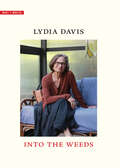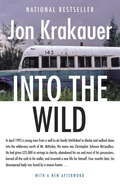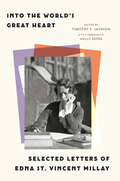- Table View
- List View
Into the Lion's Mouth: World War II Spy, Patriot, and the Real-Life Inspiration for James Bond
by Larry LoftisJames Bond has nothing on Dusko Popov. a double agent for the Abwehr, MI5 and MI6, and the FBI during World War II, Popov seduced numerous women, spoke five languages, and was a crack shot, all while maintaining his cover as a Yugoslavian diplomat... On a cool August evening in 1941, a Serbian playboy created a stir at Casino Estoril in Portugal by throwing down an outrageously large baccarat bet to humiliate his opponent. The Serbian was a British double agent, and the money-which he had just stolen from the Germans-belonged to the British. From the sideline, watching with intent interest was none other than Ian Fleming... The Serbian was Dusko Popov. As a youngster, he was expelled from his London prep school. Years later he would be arrested and banished from Germany for making derogatory statements about the Third Reich. When World War II ensued, the playboy became a spy, eventually serving three dangerous masters: the Abwehr, MI5 and MI6, and the FBI. On August 10, 1941, the Germans sent Popov to the United States to construct a spy network and gather information on Pearl Harbor. The FBI ignored his German questionnaire, but J. Edgar Hoover succeeded in blowing his cover. While MI5 desperately needed Popov to deceive the Abwehr about the D-Day invasion, they assured him that a return to the German Secret Service Headquarters in Lisbon would result in torture and execution. He went anyway... Into the Lion's Mouth is a globe-trotting account of a man's entanglement with espionage, murder, assassins, and lovers-including enemy spies and a Hollywood starlet. It is a story of subterfuge and seduction, patriotism, and cold-blooded courage. It is the story of Dusko Popov-the inspiration for James Bond. INCLUDES PHOTOGRAPHSFrom the Hardcover edition.
Into the Magic Shop
by James R. DotyExtraordinary things happen when we harness the power of both the brain and the heart Growing up in the high desert of California, Jim Doty was poor, with an alcoholic father and a mother chronically depressed and paralyzed by a stroke. Today he is the director of the Center for Compassion and Altruism Research and Education (CCARE) at Stanford University, of which the Dalai Lama is a founding benefactor. But back then his life was at a dead end until at twelve he wandered into a magic shop looking for a plastic thumb. Instead he met Ruth, a woman who taught him a series of exercises to ease his own suffering and manifest his greatest desires. Her final mandate was that he keep his heart open and teach these techniques to others. She gave him his first glimpse of the unique relationship between the brain and the heart. Doty would go on to put Ruth's practices to work with extraordinary results--power and wealth that he could only imagine as a twelve-year-old, riding his orange Sting-Ray bike. But he neglects Ruth's most important lesson, to keep his heart open, with disastrous results--until he has the opportunity to make a spectacular charitable contribution that will virtually ruin him. Part memoir, part science, part inspiration, and part practical instruction, Into the Magic Shop shows us how we can fundamentally change our lives by first changing our brains and our hearts. From the Hardcover edition.
Into the Magic Shop: A Neurosurgeon's Quest to Discover the Mysteries of the Brain and the Secrets of the Heart
by James R. DotyExtraordinary things happen when we harness the power of both the brain and the heart Growing up in the high desert of California, Jim Doty was poor, with an alcoholic father and a mother chronically depressed and paralyzed by a stroke. Today he is the director of the Center for Compassion and Altruism Research and Education (CCARE) at Stanford University, of which the Dalai Lama is a founding benefactor. But back then his life was at a dead end until at twelve he wandered into a magic shop looking for a plastic thumb. Instead he met Ruth, a woman who taught him a series of exercises to ease his own suffering and manifest his greatest desires. Her final mandate was that he keep his heart open and teach these techniques to others. She gave him his first glimpse of the unique relationship between the brain and the heart. Doty would go on to put Ruth’s practices to work with extraordinary results—power and wealth that he could only imagine as a twelve-year-old, riding his orange Sting-Ray bike. But he neglects Ruth’s most important lesson, to keep his heart open, with disastrous results—until he has the opportunity to make a spectacular charitable contribution that will virtually ruin him. Part memoir, part science, part inspiration, and part practical instruction, Into the Magic Shop shows us how we can fundamentally change our lives by first changing our brains and our hearts.
Into the Magic Shop: A Neurosurgeon's Quest to Discover the Mysteries of the Brain and the Secrets of the Heart
by James R. DotyExtraordinary things happen when we harness the power of both the brain and the heart Growing up in the high desert of California, Jim Doty was poor, with an alcoholic father and a mother chronically depressed and paralyzed by a stroke. Today he is the director of the Center for Compassion and Altruism Research and Education (CCARE) at Stanford University, of which the Dalai Lama is a founding benefactor. But back then his life was at a dead end until at twelve he wandered into a magic shop looking for a plastic thumb. Instead he met Ruth, a woman who taught him a series of exercises to ease his own suffering and manifest his greatest desires. Her final mandate was that he keep his heart open and teach these techniques to others. She gave him his first glimpse of the unique relationship between the brain and the heart. Doty would go on to put Ruth’s practices to work with extraordinary results—power and wealth that he could only imagine as a twelve-year-old, riding his orange Sting-Ray bike. But he neglects Ruth’s most important lesson, to keep his heart open, with disastrous results—until he has the opportunity to make a spectacular charitable contribution that will virtually ruin him. Part memoir, part science, part inspiration, and part practical instruction, Into the Magic Shop shows us how we can fundamentally change our lives by first changing our brains and our hearts.
Into the Magic Shop: A neurosurgeon's true story of the life-changing magic of mindfulness and compassion that inspired the hit K-pop band BTS
by Dr James DotyThe award-winning New York Times bestseller that inspired BTS's K-pop song 'Magic Shop'. The day that 12-year-old James Doty walked in to his local magic shop is the day that changed his life. Once the neglected son of an alcoholic father and a mother with chronic depression, he has gone on to become a leading neurosurgeon, based at Stanford University. He credits Ruth for this incredible turnaround: the remarkable woman he met at the Cactus Rabbit Magic Shop, who devoted the summer to transforming his mind and opening his heart.In this uplifting memoir, Jim explains the visualisation techniques Ruth taught him that gave him the self-esteem to imagine a new future for himself. He examines the science behind mindfulness and why the skills he learned - of focus and attention - now help him to think fast and keep calm in the operating theatre. And he shows us what is possible when you start to change your brain and your heart. Into the Magic Shopimparts some powerful life lessons about how to live better, and inspires us to believe that we all have inside us the capacity to change our own destiny.'I'm sure many readers will be moved by this inspiring story to open their hearts and see what they too can do for others' - His Holiness the Dalai Lama
Into the Magic Shop: A neurosurgeon's true story of the life-changing magic of mindfulness and compassion that inspired the hit K-pop band BTS
by Dr James DotyThe award-winning New York Times bestseller that inspired BTS's K-pop song 'Magic Shop'.The day that 12-year-old James Doty walked in to his local magic shop is the day that changed his life. Once the neglected son of an alcoholic father and a mother with chronic depression, he has gone on to become a leading neurosurgeon, based at Stanford University. He credits Ruth for this incredible turnaround: the remarkable woman he met at the Cactus Rabbit Magic Shop, who devoted the summer to transforming his mind and opening his heart.In this uplifting memoir, Jim explains the visualisation techniques Ruth taught him that gave him the self-esteem to imagine a new future for himself. He examines the science behind mindfulness and why the skills he learned - of focus and attention - now help him to think fast and keep calm in the operating theatre. And he shows us what is possible when you start to change your brain and your heart. Into the Magic Shop imparts some powerful life lessons about how to live better, and inspires us to believe that we all have inside us the capacity to change our own destiny.(P) 2020 Blackstone Audio, Inc.
Into the Planet: My Life As A Cave Diver
by Jill HeinerthTaking you to places no one has ever gone before, and blending memoir, adventure, and science, Into the Planet is a riveting account of one of the most dangerous yet exhilarating pursuits in the world: diving to the centre of the earth."If I die, it will be in the most glorious place that nobody has ever seen."As one of the most celebrated cave divers in the world, Jill Heinerth has seen the planet in a way almost no one has. In a workday, she might swim below your home, through conduits in volcanoes or cracks in the world's largest iceberg. She's an explorer, a scientist's eyes and hands underwater—discovering new species and examining our finite freshwater reserves—and a filmmaker documenting the wonders of underwater life. Often the lone woman in a male-dominated domain, she tests the limits of human endurance at every tight turn, risking her life with each mission. To not only survive in this world but excel, Jill has had to learn how to master self-doubt like no other.With gripping storytelling that radiates intimacy, Into the Planet will transport you deep into the most exquisite, untouched corners of the earth, where fear must be reconciled and the innermost parts of the human condition are revealed.
Into the Planet: My Life as a Cave Diver
by Jill HeinerthThe renowned cave diver takes readers on “a thrill ride into unfamiliar worlds”—exploring the hidden depths of our oceans and sunken caves (Publishers Weekly).More people have died exploring underwater caves than climbing Mount Everest, and we know more about deep space than we do about the depths of our oceans. In this thrilling firsthand account, Jill Heinerth blends science, adventure, and memoir to bring readers face-to-face with the terror and beauty of earth’s final frontier—and the extremes of human capability.One of the world’s foremost cave divers, Heinerth’s achievements include leading a team that discovered the ancient watery remains of Mayan civilizations and becoming the first person in history to dive deep into an Antarctic iceberg. In Into the Planet, she vividly recounts everything from discovering new species and examining our finite freshwater reserves to the prejudices women face when pursuing careers underwater.
Into the Rip: How the Australian Way of Risk Made My Family Stronger, Happier ... and Less American
by Damien CaveWhen Damien Cave brought his young family to Sydney to set up the New York Times&’ Australian Bureau, they encountered the local pursuits of Nippers and surfing – and a completely different approach to risk that changed the way they lived their lives. Damien Cave has always been fascinated by risk. Having covered the war in Iraq and moved to Mexico City with two babies in nappies, he and his wife Diana thought they understood something about the subject. But when they arrived in Sydney so that Cave could establish The New York Times&’s Australia Bureau, life near the ocean confronted them with new ideas and questions, at odds with their American mindset that risk was a matter of individual choices. Surf-lifesaving and Nippers showed that perhaps it could be managed together, by communities. And instead of being either eliminated or romanticised, it might instead be respected and even embraced. And so Cave set out to understand how our current attitude to risk developed – and why it&’s not necessarily good for us.Into the Rip is partly the story of this New York family learning to live better by living with the sea and it is partly the story of how humans manage the idea of risk. Interviewing experts and everyday heroes, Cave asks critical questions like: Is safety overrated? Why do we miscalculate risk so often and how can we improve? Is it selfish to take risks or can more exposure make for stronger families, citizens and nations? And how do we factor in legitimate fears and major disasters like Cave has covered in his time here: the Black Summer fires; the Christchurch massacre; and, of course, Covid? The result is Grit meets Phosphorescence and Any Ordinary Day – a book that will change the way you and your family think about facing the world&’s hazards. &‘The inspiring, hilarious story of how Damien Cave became a life-saver – only to find that the life he saved was his own.&’ Richard Glover 'It often takes a stranger&’s eyes to see our own country clearly. By plunging into the Sydney surf, Damien Cave peered into the Australian soul. What he found there – courage, grit, community – is welcome news when our lives and our core values have never seemed so precarious.' Geraldine Brooks &‘Into the Rip is a beautiful tale of one family trying to figure things out – and, at the same time, a brilliant synthesis of a century of psychological science on how all of us can learn to dive headfirst into challenges, grow and adapt, and ultimately do well in life.&’ Angela Duckworth, New York Times bestselling author of Grit 'Cave&’s viewfinder – the notion of risk – is perfect for our times.' Malcolm Knox &‘A big-hearted account of a wild and wonderful ride into a new culture and a new way to live.&’ Anna Funder
Into the Rising Sun: In Their Own Words, World War II's Pacific Veteran
by Patrick K. O'Donnell"Iwo Jima was a massacre. I never expected anything like that. People were dying left and right...No names should have been used on the flag raisings because we didn't get up there by ourselves. It was the collective actions of a lot of people and there were a lot of Raiders and paratroopers up there with us." -- Charles Lindberg, Flag RaiserPatrick O'Donnell has made a career of uncovering the hidden history of World War II by tracking down and interviewing its most elite troops: the Rangers, Airborne, Marines, and First Special Service Force, forerunners to America's Special Forces. These men saw the worst of the war's action, and most of them have been reluctant to talk about it. With O'Donnell's respectful coaxing, however, they first began telling their stories through www.thedropzone.org, his award-winning Web site. In 2001, veterans of the European Theater told their stories in O'Donnell's first book, Beyond Valor. Now, in Into the Rising Sun, O'Donnell presents scores of veterans' personal accounts, based on over a thousand interviews spanning the past ten years, to tell the story of the brutal Pacific war."They were making a lot of noise, talking, yelling to one another, and I heard someone getting beat up on the left. I can still hear the screams. He was begging for mercy. They [the Japanese] were berating him. Later on I found that it was one of my friends, Ken Ritter." -- Robert Youngdeer, GuadalcanalThese veterans were often the first in and the last out of every conflict, from Guadalcanal and Burma to the Philippines and the black sands of Iwo Jima. They faced a cruel enemy willing to try anything, including kamikaze flights and human-guided torpedoes. As O'Donnell explains in the Introduction, most of the men in this book were at first reticent to talk. Over the course of the war, they had spearheaded D-Day-sized beach assaults, encountered cannibalism, suffered friendly-fire incidents, and endured torture as pris-oners of war. Heroes among heroes, they include many recipients of the Navy Cross, the Distinguished Service Cross, the Silver Star, and other medals of battlefield valor, but none bragged about it. As one soldier put it, "When somebody gets decorated, it's because a lot of other men died." By at last telling their stories, these men present an unvarnished look at the war on the ground, a final gift from aging warriors who have already given so much. Only with these accounts can the true horror of the war in the Pacific be fully known. O'Donnell has carefully verified each account by comparing it with official records and interviews, and he intersperses each story with brief commentary. Together with detailed maps of each battle, the veterans' stories in Into the Rising Sun offer nothing less than a complete picture of the war in the Pacific, a ground-level view of some of history's most brutal combat.
Into the Silence: The Great War, Mallory and the Conquest of Everest
by Wade DavisOn June 6, 1924, two men set out from a camp perched at 23,000 feet on an ice ledge just below the lip of Mount Everest's North Col. George Mallory, thirty-seven, was Britain's finest climber. Sandy Irvine was a young Oxford scholar of twenty-two with little previous mountaineering experience. Neither of them returned. In this magisterial work of history and adventure, based on more than a decade of prodigious research in British, Canadian, and European archives, and months in the field in Nepal and Tibet, Wade Davis vividly re-creates British climbers' epic attempts to scale Mount Everest in the early 1920s. With new access to letters and diaries, Davis recounts the heroic efforts of George Mallory and his fellow climbers to conquer the mountain in the face of treacherous terrain and furious weather. Into the Silence sets their remarkable achievements in sweeping historical context: Davis shows how the exploration originated in nineteenth-century imperial ambitions, and he takes us far beyond the Himalayas to the trenches of World War I, where Mallory and his generation found themselves and their world utterly shattered. In the wake of the war that destroyed all notions of honor and decency, the Everest expeditions, led by these scions of Britain's elite, emerged as a symbol of national redemption and hope. Beautifully written and rich with detail, Into the Silence is a classic account of exploration and endurance, and a timeless portrait of an extraordinary generation of adventurers, soldiers, and mountaineers the likes of which we will never see again.From the Hardcover edition.
Into the Soul of the World: My Journey to Healing
by Brad WetzlerThis powerful memoir shares an adventure journalist&’s story of a decade-long, round-the-world quest to overcome his drug addiction and to understand and heal from past traumas. Suffering from PTSD and severe depression from past trauma, battling an addiction to overprescribed psychiatric medication, and at the rock bottom of his career, journalist Brad Wetzler had nowhere to go. So he set out on a journey to wander and hopefully find himself—and the world—again. Into the Soul of the World is Wetzler&’s thrilling, impactful, and heartrending memoir of healing—physically, emotionally, and spiritually. An adventure journalist at heart, Wetzler mixes travelogue with empowering insights about his inner journey to better care for his own mental health. Journey with him as he travels across Israel and the West Bank, before moving on to India, a candle-lit cave on a mountaintop in the Himalayan foothills, and a life-changing encounter with a 100-year-old yogi. Wetzler's writing is full of the poignant, amusing, and occasionally heart‑breaking situations that unfold when we finally decide to confront depression (or any mental health struggle) and declare ourselves ready to heal: How do we heal our past and thrive again? What does it mean to live a good life? How can we transform our suffering and serve others? His answer: live to tell the story and find the humility and courage to be the best human you can be.
Into the Storm: Two Ships, a Deadly Hurricane, and an Epic Battle for Survival
by Tristram Korten“An intense, immersive deep dive into a wild, dangerous, and unknown world, written with the pace and appeal of a great thriller. This is nonfiction at its very best.”—Lee ChildThe true story of two doomed ships and a daring search-and-rescue operation that shines a light on the elite Coast Guard swimmers trained for the most dangerous ocean missions In late September 2015, Hurricane Joaquin swept past the Bahamas and swallowed a pair of cargo vessels in its destructive path: El Faro, a 790-foot American behemoth with a crew of thirty-three, and the Minouche, a 230-foot freighter with a dozen sailors aboard. From the parallel stories of these ships and their final journeys, Tristram Korten weaves a remarkable tale of two veteran sea captains from very different worlds, the harrowing ordeals of their desperate crews, and the Coast Guard’s extraordinary battle against a storm that defied prediction. When the Coast Guard received word from Captain Renelo Gelera that the Minouche was taking on water on the night of October 1, the servicemen on duty helicoptered through Joaquin to the sinking ship. Rescue swimmer Ben Cournia dropped into the sea—in the middle of a raging tropical cyclone, in the dark—and churned through the monstrous swells, loading survivors into a rescue basket dangling from the helicopter as its pilot struggled against the tempest. With pulsating narrative skill in the tradition of Sebastian Junger and Jon Krakauer, Korten recounts the heroic efforts by Cournia and his fellow guardsmen to haul the Minouche’s crew to safety. Tragically, things would not go as well for Captain Michael Davidson and El Faro. Despite exhaustive searching by her would-be rescuers, the loss of the vessel became the largest U.S. maritime disaster in decades. As Korten narrates the ships’ fates, with insights drawn from insider access to crew members, Coast Guard teams, and their families, he delivers a moving and propulsive story of men in peril, the international brotherhood of mariners, and the breathtaking power of nature.Advance praise for Into the Storm “An incredible story and first-rate adventure . . . Tristram Korten delivers us into a thrilling and dangerous world, strapping us in beside everyday heroes who confront forces of nature even Hollywood can’t re-create.”—Robert Kurson, New York Times bestselling author of Shadow Divers “A terrifying but also inspiring story of disaster and resilience on the high seas . . . riveting stuff.”—Josh Dean, author of The Taking of K-129
Into the Story: A Writer's Journey Through Life, Politics, Sports and Loss
by David MaranissOne of the most successful and honored reporter-writers of his day selects pieces that illustrate his own education as a writer.
Into the Taylor-Verse: Taylor Swift's Songwriting Eras
by Satu Hämeenaho-FoxA beautifully illustrated, comprehensive collectible for Swifties everywhere that offers an overview of Taylor Swift&’s life and work, including hidden references for fans to discover in a stunning, giftable package.Into the Taylor-Verse is an inventive, deeply detailed appreciation of Taylor Swift&’s songwriting prowess, her incomparable live performances, and the themes of adolescence and adulthood she&’s detailed so lovingly throughout the different eras of her career from her Fearless to Midnights. This book explores her prolific discography, as well as her worldwide tours, her phoenix-like rise from the ashes to reclaim her music publishing rights, and most importantly of all, her Swifties. In the way that Taylor&’s music helps fans to understand their own emotional response to heartbreak and first love, this book seeks to help fans understand why Taylor&’s music affects them more than any other artist. The story told through her work is the universal story of growing from a girl into a woman, the joy, heartbreak, demoralization, and finally, regrowth and maturity that every fan can relate to no matter their age. This book emulates the joy of Taylor&’s music with creative sidebar content, such as a playlist of her songs that are NOT about boys, an all-important timeline of her hairstyles, biographies of her cats, a deep-dive into the significance of the number thirteen, and so much more. Into the Taylor-Verse is a must-have primer on Taylor for any new Swiftie, telling the stories behind her songs and guiding them to listen more deeply to her extensive back catalogue, while also being a lush examination of the meaning behind the songs that are so important to readers who are already dedicated fans.
Into the Uncut Grass
by Trevor NoahFrom the author of the #1 bestselling Born a Crime comes a fable for all ages.'What will we find in the uncut grass?'It depends on what we're looking for.'From the author of the #1 bestselling Born a Crime comes a fable about a young child's journey into the world beyond the shadow of home, an enchanted landscape where he discovers the secrets of solidarity, connection, and finding peace with the people we love.Infused with the author's signature wit and imagination, it's a tale for readers and listeners of all ages.
Into the Uncut Grass
by Trevor NoahTHE INSTANT NEW YORK TIMES BESTSELLER 'What will we find in the uncut grass?'It depends on what we're looking for.'From the author of the #1 bestselling Born a Crime comes a gorgeously illustrated fable about a young child's journey into the world beyond the shadow of home, an enchanted landscape where he discovers the secrets of solidarity, connection, and finding peace with the people we love.Infused with the author's signature wit and imagination, in collaboration with masterful artist Sabina Hahn, it's a tale for readers of all ages - to be read aloud or read alone.
Into the Unknown
by Matthew A. HensonThe adventures of three Arctic explorers-Fridtj of Nansen, Robert Edwin Peary, and Matthew A. Henson-are told in this compilation of biographical and autobiographical stories.
Into the Unknown: High Adventure and Hard Lessons Exploring the World's Great, Lost Wilderness Rivers
by Michael P. GhiglieriVeteran wilderness guide Michael P. Ghiglieri takes you into the unknown—among white-water rapids, crocodiles, hippos, gorillas, lions, and impossible waterfalls. His riveting memoir not only serves up true high adventure, it also presents the ecology, natural history, conservation (or the lack of it), and exploration history of nine far-flung wilderness regions across the globe—including the never-to-be-repeated white-water run on the Colorado River through the Grand Canyon during the Bureau of Reclamation’s 1983 super flood of ninety-seven thousand cubic feet per second; the first summit-to-sea descent of the Alas River exploring Sumatra’s new Gunung Leuser National Park, a last redoubt for wild orangutans and other rare species; and the “impossible” run of the Alsek River from the Yukon to Alaska in the world’s largest international conservation area.Into the Unknown reveals what the natural world looks like through a professional’s eyes during “adventure” travel, when things start sliding toward the edge. This insider memoir recounts ten sagas of extreme expeditions into Earth’s most amazing wilderness regions to illustrate their realities, science, allure, history, risks to life and limb, and ultimate fates. Many of these regions have now vanished to “progress.” Others are imperiled. Only a few are protected. But all are, or were, places where exotic beauty and danger are inseparable.
Into the Valley of Death: The Light Cavalry at Balaclava
by Nick ThomasUnique work that details the status of each man known to have taken an active part in the Charge, listing the evidence supporting their case for inclusion among the ranks of the immortal Light Cavalry Brigade.Into the Valley of Death tells the thrilling story of the Charge of the Light Brigade in the words of the men who fought during the most heroic and yet futile engagement of the modern era. By drawing on key evidence the author has not only provided a clear narrative of the events leading up to the 25th October 1854, but has painted a vivid picture of the Charge itself. No punches are pulled and the carnage which ensued is clear for all to read, dispelling the romantic myth of ‘death or glory’ fostered by the Victorians. This work tells the blood and guts story of a desperate charge by 673 men in the face of what seemed insurmountable odds. It reveals the trauma endured by the rank and file who witnessed all around them men and horses cut to pieces while endeavoring to ride through walls of flying iron and lead, and not knowing if the next second would be their last. Yet in the midst of this horror and devastation, the author takes time to give an overview of the battle itself and puts on the hats of some of the commanders involved, looking at not only what they did, but also at how a terrible disaster could so easily have been turned into the greatest single victory of its time. Could such an apparently mad-cap charge have succeeded? Did sufficient men arrive at the guns to successfully capture them? Were there troops and close support that could have been utilized to drastically change the course of events? Could a simple stalling tactic have allowed these resources to have been fully exploited? All of these questions are answered. This work truly lifts the lid on the events of over 150 years ago and through the words of the survivors allows the reader to assign the responsibility for the Charge having taken place and for the consequent loss of the Light Brigade.
Into the Void: From Birth to Black Sabbath—And Beyond
by Geezer ButlerA rollicking, effusive, and candid memoir by the heavy metal musician and founding member of Black Sabbath, covering his years as the band’s bassist and main lyricist through his later-career projects, and detailing how one of rock’s most influential bands formed and prevailed. With over 70 million records sold, Black Sabbath, dubbed by Rolling Stone “the Beatles of heavy metal,” helped create the genre itself, with their distinctive heavy riffs, tuned down guitars, and apocalyptic lyrics. Bassist and primary lyricist Geezer Butler played a gigantic part in the band’s renown, from suggesting the band name to using his fascination with horror, religion, and the occult to compose the lyrics and build the foundation of heavy metal as we know it.In Into the Void, Butler tells his side of the story, from the band’s beginnings as a scrappy blues quartet in Birmingham through the struggles leading to the many well-documented lineup changes while touring around London’s gritty clubs (Eric Clapton, Jimi Hendrix, Frank Zappa, and The Who makes notable appearances!), and the band’s important later years. He writes honestly of his childhood in a working-class family of seven in Luftwaffe-battered Birmingham, his almost-life as an accountant, and how his disillusionment with organized religion and class systems would spawn the lyrics and artistic themes that would resonate so powerfully with fans around the world.Into the Void reveals the softer side of the heavy metal legend and the formation of one of rock’s most exciting bands, while holding nothing back. Like Geezer’s bass lines, it is both original, dramatic, and forever surprising.
Into the Weeds (Why I Write)
by Lydia DavisAn illuminating reflection on the creative process from acclaimed fiction writer, essayist, and translator Lydia Davis“Reporting from the slipstream of her reading life, [Davis] offers less a new way to think than perhaps an old one, pushing back against mechanization and the collapse of context by reframing reading in the most particular and human terms.†?—David L. Ulin, The Atlantic When asked why she writes, Lydia Davis confesses that the question makes her uncomfortable. Maybe she would rather not know. Instead, Davis considers how she writes her stories, how other writers write, and what insights the how might provide into the why. In this free-ranging exploration, Davis discovers that one reason she writes is for pleasure: the pleasure of encountering something that demands to be treated in language, of handling and manipulating the language into the form it ought to take, and, finally, of seeing a story exist where it didn’t exist before. As she observes the processes of some of the authors who interest her the most, she finds that there seem to be as many reasons to write as there are writers: to relive an experience, to share an experience, to articulate something one has not quite comprehended. Reflecting on an eclectic mix of thinkers, including James Baldwin, Kate Briggs, Walter Raleigh, Christina Sharpe, Knut Hamsun, Grace Paley, Josep Pla, John Ashbery, and John Clare, Davis undertakes a clear-eyed, patient inquiry into the manifold reasons we choose to put pen to paper and begin something new.
Into the Wild
by Jon KrakauerNATIONAL BESTSELLER • In April 1992 a young man from a well-to-do family hitchhiked to Alaska and walked alone into the wilderness north of Mt. McKinley. Four months later, his decomposed body was found by a moose hunter. This is the unforgettable story of how Christopher Johnson McCandless came to die."It may be nonfiction, but Into the Wild is a mystery of the highest order." —Entertainment WeeklyMcCandess had given $25,000 in savings to charity, abandoned his car and most of his possessions, burned all the cash in his wallet, and invented a new life for himself. Not long after, he was dead. Into the Wild is the mesmerizing, heartbreaking tale of an enigmatic young man who goes missing in the wild and whose story captured the world&’s attention. Immediately after graduating from college in 1991, McCandless had roamed through the West and Southwest on a vision quest like those made by his heroes Jack London and John Muir. In the Mojave Desert he abandoned his car, stripped it of its license plates, and burned all of his cash. He would give himself a new name, Alexander Supertramp, and, unencumbered by money and belongings, he would be free to wallow in the raw, unfiltered experiences that nature presented. Craving a blank spot on the map, McCandless simply threw the maps away. Leaving behind his desperate parents and sister, he vanished into the wild.Jon Krakauer constructs a clarifying prism through which he reassembles the disquieting facts of McCandless's short life. Admitting an interest that borders on obsession, he searches for the clues to the drives and desires that propelled McCandless. When McCandless's innocent mistakes turn out to be irreversible and fatal, he becomes the stuff of tabloid headlines and is dismissed for his naiveté, pretensions, and hubris. He is said to have had a death wish but wanting to die is a very different thing from being compelled to look over the edge. Krakauer brings McCandless's uncompromising pilgrimage out of the shadows, and the peril, adversity, and renunciation sought by this enigmatic young man are illuminated with a rare understanding—and not an ounce of sentimentality. Into the Wild is a tour de force. The power and luminosity of Jon Krakauer's stoytelling blaze through every page.
Into the World’s Great Heart: Selected Letters of Edna St. Vincent Millay
by Edna St. MillayAn annotated selection of the letters of the Pulitzer Prize–winning poet and playwright Edna St. Vincent Millay, from childhood through the last year of her life Throughout her life, Edna St. Vincent Millay wrote hundreds of letters, which together create a colorful tapestry of her inner life. This selection, based on archival research, represents Millay&’s correspondence from 1900, when she was eight, until 1950, the last year of her life. Through her letters, readers encounter the vast range of Millay&’s interests, including world literature, music, and horse racing, as well as her commitment to gender equality and social justice. This collection, edited by Timothy F. Jackson, includes previously unpublished correspondence, as well as letters containing early versions of poems, revealing new dimensions in Millay&’s creative process and influences. It is enriched by Jackson&’s thoughtful introduction and notes, plus a foreword by Millay&’s literary executor, Holly Peppe. Millay&’s observations on her inner life and the world around her—which speak to contemporary concerns as well—add to our understanding of American literature in the first half of the twentieth century.
